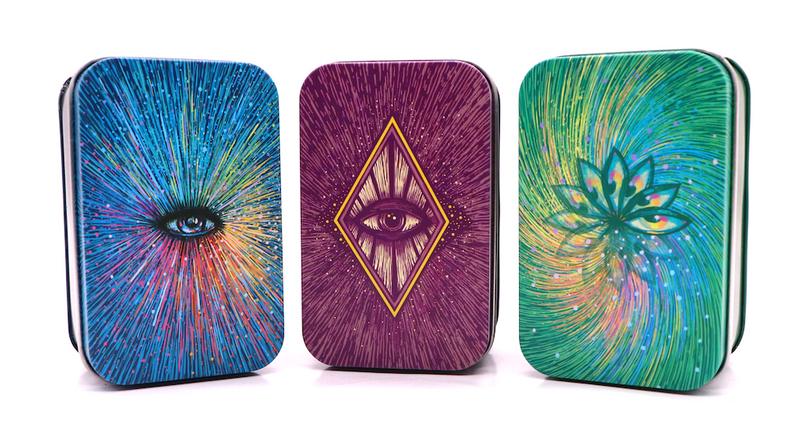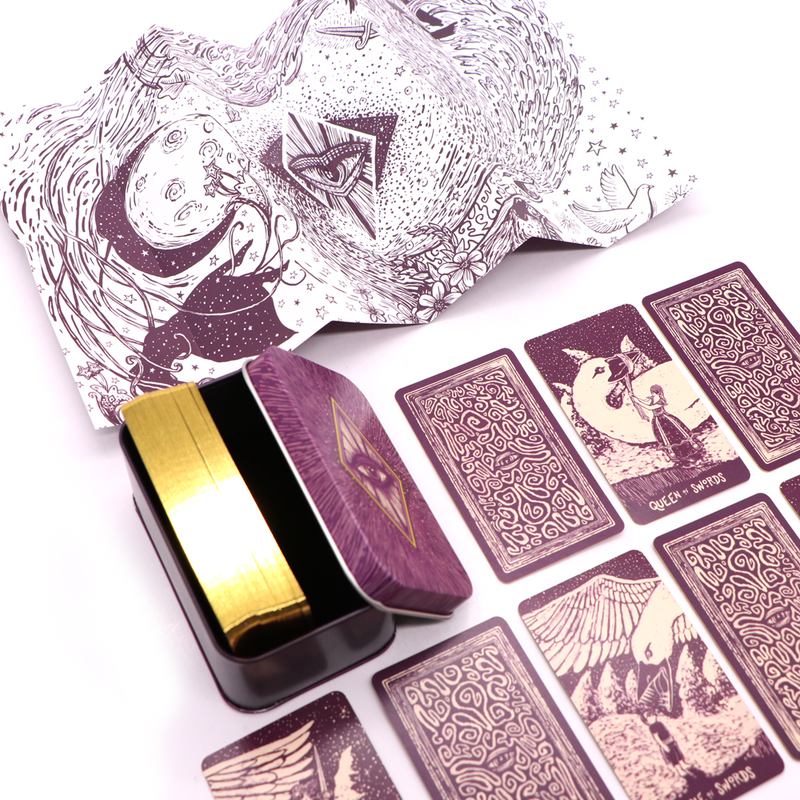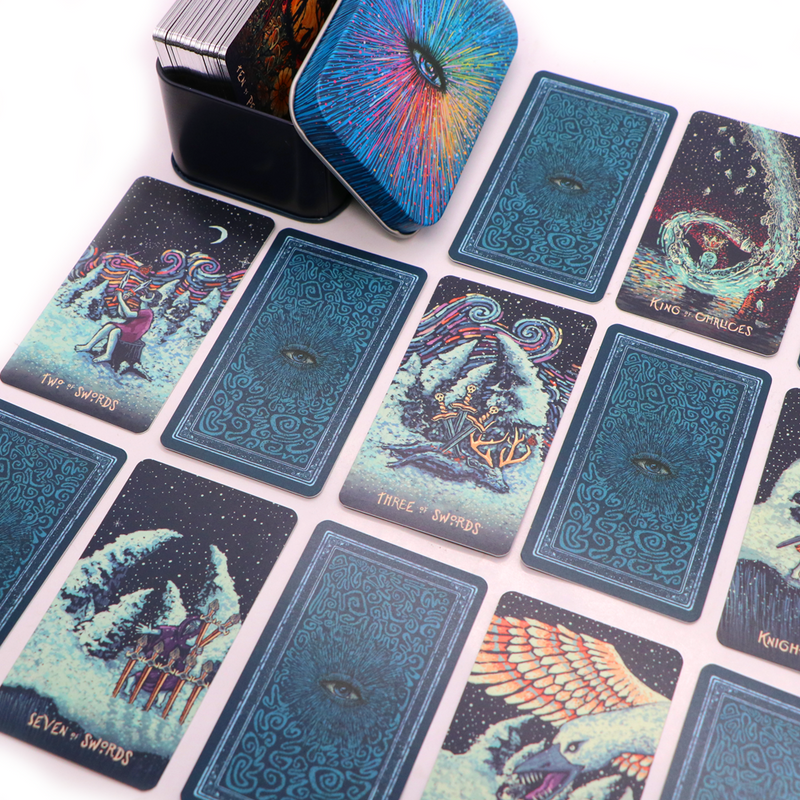You draw and paint otherworldly scenes, of a boy and a peacock meeting in front of the glowing moon or mushrooms blooming as tall as skyscrapers. How do you come up with images that don’t exist?
I like to create landscapes and places that seem like they could almost exist here but not quite, like everything is a little shifted to the left. You might call it magical realism. These scenes are very familiar: “Okay, it’s a gazebo in a garden,” and we know what that looks like. But then it’s surreal and trippier and the light is illuminating everything in a different way. I hope to hold people a little longer, to realize that their garden—their life—is precious and magical and worth living.
Because inspiration is coming from everywhere, even the mundane, it’s tough to pinpoint. Music is always important, and I usually can look at a finished piece and link it to a specific playlist or song. Especially with the movement in my work, I do this weird thing where I get into a flow state and I listen to the same song on repeat for an hour and it helps me put myself in the world I’m creating.
What are some of the tracks you’ve been repeating lately?
I like long songs for a continuous vibe. “I Trawl the Megahertz” by the 80s band Prefab Sprout is super weird, almost like talk radio, sort of jazzy, ideal for a rainy night. I like to work late. I feel like the creative hours are 10 p.m. to 2 a.m. That’s primetime. “In Another Life” by Sandro Perri is another 20-minute, beautiful song that reminds me of a past life situation, which also inspires my work. I got really into past lives around 2015 and did a bunch of past life regressions on my own, aided by audio, as a form of meditation. [“In Another Life”] brings me back to that feeling from a specific moment in time. It’s almost like I’m referencing past versions of myself, incorporating into my art little moments that stand out even if they seem insignificant.
Your most popular works are your decks of tarot cards. What is the connection between tarot, or magic, or past lives, and fine art?
There’s an underlying spirituality aspect, of reaching for a collective unconscious or subconscious remembrance of where we potentially came from and why we’re linked together as humans. Art is trying to represent those discoveries. With art and tarot, we have the classic Rider-Waite deck that everyone picks up at a wiccan shop when they’re 13. It’s very medieval, very antiquated. When I first started making tarot decks in 2013, I wanted to broach something a little more accessible to people in current day. The Rider-Waite imagery is from the Victorian era; things have changed a lot since then. LGBTQ people aren’t really represented in that tarot deck, or POC. I wanted to create a cosmic, astral deck that doesn’t have a grounding point in human history but could be timeless.
How do you create new imagery for a centuries-old practice? What is your relationship to the existing, ancient symbols?
That’s the trick. I use symbolism from Rider-Waite and other decks in small ways as an underlying link, so it’s not a huge jump for a tarot reader to use a deck I’ve made. With a recent series of astrological prints, I wanted to keep the original symbols because I think that for the most part they are worth keeping. The familiarity is useful in a system that has become universal and repeated over and over again. But there are deviations. With Libra, the imagery of scales is very flat to me; all the other signs are animals or people. There’s no birds in the zodiac for some reason, so I animated Libra with one. Virgo is always a naked woman with a cloth draped over her or something, and I wanted a more androgynous vibe. Because there are Virgo men! As an artist, that’s part of my goal, to level the playing field and make it so everybody can feel represented and can relate to something that maybe previously they didn’t feel accepted by.
I think you’re also leveling the playing field of art with the mediums that you use. Decks of cards, blankets, puzzles, these are all functional things, very different from a framed painting on a wall. What interests you about this mode of making?
In college, my major was traditional printmaking. It’s probably inspired everything I do now. When I moved to Brooklyn after graduating, I didn’t have any space to make art so I taught myself how to use a Wacom tablet. What I do now is create digital art that has this feeling of being traditional art so people immediately feel like ‘This is a tactile art form that I can relate to and I know about’ versus heavily digital art can sometimes feel largely computer-generated.
The digital process makes it easier to produce higher quantities, makes it way more affordable for people. But there’s something special about being able to feel the art versus just seeing it on your phone, you know? We try to make new limited edition prints every month and we add little effects like glitter and gold leaf that catch the light, that three-dimensional aspect. For the tarot cards, I spend a lot of time sourcing different paper qualities. Sometimes there’s a buttery finish, sometimes it’s glossy or matte. That’s really important to me because you want the cards to feel good in your hands as you’re reading them.
Who is ‘we’?
Having a team, it feels like there’s four of me. It makes the possibilities tenfold. I hired my first assistant in 2014, after the first tarot deck took off, and now I have four employees: a screen-printer who prints everything I make, a fulfillment specialist who deals with all the shop orders, a production manager who runs the show, and someone who does special projects — which is all over the place right now, but we are building a giant installation in the upstairs of our studio that will be a walkthrough forest shrine. So I don’t feel like I’m running a business and being an artist. I mean I am, but it’s hard to purely create when you have logistics to worry about.
Once you’ve made a business out of your creative practice, is it possible to make art that you don’t intend to sell?
There’s definitely art that’s for me and art that’s for everybody. But the line gets more and more blurred as time goes on. A lot of the art that is originally for me morphs into something else that eventually becomes seen. It is an interesting thing to grapple with in current, social media days. It feels like accessibility equals existence. People want to see what you’re making, but you also feel somewhat obligated to show it. You start questioning, “Am I doing this art because it makes me happy or am I doing it for other people?” You can really lose hold of why you started making art in the first place.
Why did you start making art in the first place?
Art is a form of fulfillment. One of our most unique aspects as human beings is that we can create things, and if we can, then we should create versus destroy. I feel like art is in opposition to a lot of negativity that we see in the world. For me, it’s meditative, it’s healing, it calms me down and makes me excited. It fuels me to be a better person and inspires me to want to make more art. I think that a lot of people wonder, what is the purpose of life and what am I doing with mine? Making art calms those feelings for me.
Speaking of negativity, you had an unpleasant experience with NFTs earlier this year. Someone was impersonating you, making copies of your work and selling them at a really low price. What has been your experience with NFTs as an artist who has already been experimenting with digital possibilities?
At the beginning of the year, I almost felt like I’d missed the NFTs boat … People were making a billion dollars and I raced to get in because I feel like I have a lot of applicable pieces. At the same time, NFTs were this super concentrated hype that the pandemic elevated because we were all feeling disconnected at home and suddenly there’s weird, collectible art that everyone can potentially take a part of. There was a point where all I was seeing was NFTs and it was nauseating.
When I released an NFT in March, it was right before I started hearing about all the negative environmental impacts of crypto. I pulled back; it wasn’t something that I needed to be involved in at the time being. Then people started contacting me about this account that was basically minting NFTs of all my art, changing the names of the images into really weird titles and then ceding them to people for free so that buyers can resell them and the original person gets a second-market sale. That’s how NFTs are valuable for artists, as an alternative to the traditional auction houses and galleries that take huge chunks.
But in this case the actual artist isn’t getting anything.
It sucked, but this isn’t new to me. I’ve been dealing with counterfeits for years. A big part of what we do at the studios is take down illegal dupes of all the tarot decks that we’ve made, all our prints… It can be exhausting. I have a copyright lawyer on retainer and that gets expensive. I think it’s just part of being alive and an artist that is somewhat successful in 2021.
You have chosen to fund your art in a very different way, relying on Kickstarter campaigns and your social media following. How does that affect the art itself?
I was literally just writing an update on our stretch goal for Little Visions and how I like hearing everybody’s opinion on projects because I end up making things that I would never have done before. I don’t have that perspective as the creator, and it’s nice to hear from the consumer, like, ‘I want a double-sided altar cloth or a card holder to hold my card of the day.’ I feel like my whole life is crowdfunding, in a way. Prints are a form of crowdfunding, selling 50 to 100 $50 items to many people versus selling one painting to one person. It provides a feeling of being connected, being a part of something that a lot of other strangers are sharing. Only good can come from that.
James R. Eads Recommends:
Codex Seraphinianus, an illustrated encyclopedia of an imaginary world by Luigi Serafini
“I Trawl the Megahertz” by Prefab Sprout (song)
Useless Creatures by Andrew Bird (album)
Tales from the Loop, sci-fi TV show
brown sugar milk tea ice cream bars
This content originally appeared on The Creative Independent and was authored by Greta Rainbow.
Greta Rainbow | Radio Free (2021-11-02T07:00:00+00:00) Visual artist James R. Eads on making work for yourself and for everybody. Retrieved from https://www.radiofree.org/2021/11/02/visual-artist-james-r-eads-on-making-work-for-yourself-and-for-everybody/
Please log in to upload a file.
There are no updates yet.
Click the Upload button above to add an update.



